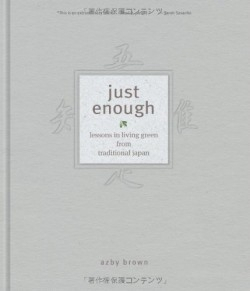Just Enough
Lessons in Living Green from Traditional Japan
In the early 1600s, in the beginning of the Edo period in Japan, nearly all suitable land had been opened to cultivation; soils were beginning to exhaust and forests were showing substantial signs of degradation. The population was 12 million. Two hundred years later the same land supported a population of 30 million. “Deforestation had been halted and reversed, farmland improvedÂ…and conservation implemented in all sectors of societyÂ….Overall living standards had increased, and the people were better fed, housed, and clothed, and they were healthier,” Azby Brown writes. In Just Enough, Brown explains how this feat was accomplished. Part anthropologic documentary, part how-to manual, this lucid and artfully compiled book explores both the rural and urban life of Japan’s influential Edo period. Brown’s timely study provides a successful model to consider as we struggle toward a more sustainable society.
Supplemented beautifully by sketches and diagrams on nearly every page, Brown describes all facets of life, including social organization, civil engineering, construction and home design, and resource efficiency. If you have always wanted to know how to thatch a roof or winnow rice, these tasks are artfully illustrated. A chart describing building materials and all their virtues-including durability, environmental impact, costs and constraints, useful byproducts, and possible reuse-provides more applicable information. In two sections, “Field and Forest” and “The Sustainable City,” Brown leads the reader like a tour guide across the region. At the close of each section is an in-depth discussion of lessons to be learned and how they might be applied today. Rethinking the meaning of comfort, looking for beauty in function, and utilizing human waste in agriculture versus expending energy to treat waste are a few ideas presented.
Often praised for its aesthetic of simplicity and utility, remnants of Japan’s Edo period have continued to influence a variety of innovations in design. This rare and detailed account encompasses the entire societal framework and philosophies which spurred this aesthetic of “just enough,” this beauty born of scarcity. Taking a lesson from this aesthetic, Brown’s elegant and accessible text with its lucid illustrations make this a wonderful companion for students and professionals in the fields of design, civil engineering, farming, construction, or Japanese history, or any person interested in leaving a more delicate footprint on the planet. (February) Jen Sperry Steinorth
Disclosure: This article is not an endorsement, but a review. The publisher of this book provided free copies of the book to have their book reviewed by a professional reviewer. No fee was paid by the publisher for this review. Foreword Reviews only recommends books that we love. Foreword Magazine, Inc. is disclosing this in accordance with the Federal Trade Commission’s 16 CFR, Part 255.

